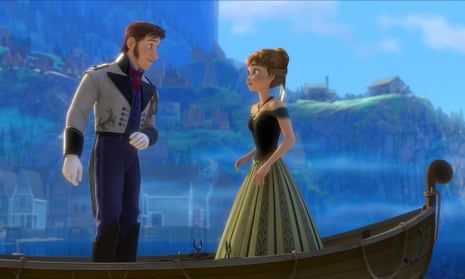Like, I’m sure, every creator of animated movies in the world, I’ve spent the last year trying to unpick what made Frozen a phenomenon that outstripped all expectations. When your children develop an obsession you can either tolerate it, resent it or embrace it. I chose the latter, partly for the sake of my sanity, and partly because, as a critic, I’m fascinated by the nature of extreme popularity.
Frozen has become more than just a very good Disney movie; it’s a generational set text, like Star Wars, Harry Potter or the Beatles. Bad taste can elevate certain movies to a certain level of popularity, but only truly substantial ones reach the stratosphere. After a year of Frozen merchandise, Frozen birthday parties and Frozen singalongs, I’m pretty sure that several million children can’t be wrong.
When you have become more intimate with Frozen than you have with any work of art in your entire goddamn life, you come to appreciate its rock-solid artistry. The first third, especially, is a bravura feat of storytelling, achieved mostly through songs, that sets up the movie’s themes and symbolism (count the references to doors) while foreshadowing all of the major plot developments. For students of screenwriting and songwriting alike, it’s a master class in narrative precision and tonal shifts, all of which gives it staying power. If I’d been forced to watch, say, Ice Age 4 this many times then I’d have a broken television and a bandaged foot by now.
One way of approaching children’s movies is to sprinkle the kids’ stuff with subtly risqué jokes and movie references to keep the parents happy: the Shrek strategy. But my two daughters, three and eight, like Frozen for the same reasons I do. OK, so they probably haven’t clocked the triple meaning of “Beware the frozen heart” in the opening song but they respond to the plot’s sense of jeopardy. They wouldn’t describe the final repudiation of the true-love’s-kiss cliché as feminist but they get that it’s unusual and empowering to make the emotional hinge the relationship between two sisters.
Even my three-year-old is hooked not on goofy Olaf or plucky Anna but on Elsa: emotionally stunted, psychologically traumatised, physically dangerous Elsa, who does the work of both hero and villain. And it’s not just because of Let It Go, the flawlessly crafted first-act showstopper whose ubiquity recently led director Jennifer Lee to make a tongue-in-cheek apology. For me there’s no apology needed. It’s become like Hey Jude or My Way: part of the pop-culture atmosphere, neither thrilling nor grating but simply there. (FYI, Fixer Upper and Frozen Heart are the crate-diggers’ choices.)
As this Christmas’s merchandising avalanche marks the peak, surely, of Frozenmania, I understand why some of my fellow parents are thoroughly sick of the whole thing. Even I have finally run out of new details to discover in a film from which my family could reenact entire scenes. But it has been fascinating to watch the evolution of a phenomenon in microcosm. I’ve enjoyed introducing my daughters to the likes of The Simpsons, David Bowie and Singin’ in the Rain, but it’s been just as fulfilling to follow their lead and immerse myself in a work of art that belongs to them, especially when it’s a movie about the need for empathy and maintaining strong bonds. Like the song says, love is an open door.

Comments (…)
Sign in or create your Guardian account to join the discussion